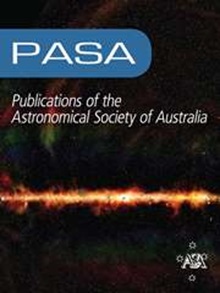GNOMES II:用变形虫分析所有四种基态羟基跃迁中的银河漫射分子ISM
IF 4.6
3区 物理与天体物理
Q1 ASTRONOMY & ASTROPHYSICS
引用次数: 0
摘要
摘要:我们在银河面内外的107条视线上对羟基分子(OH)的4次$^2 \Pi _{3/2}\,J=3/2$地旋态跃迁进行了观测,其中92组观测来自阿雷西博望远镜,15组观测来自澳大利亚望远镜紧凑阵列(ATCA)。我们的阿雷西博观测包括非源点,允许我们测量激发温度($T_{\rm ex}$)和光学深度,而我们的ATCA观测只给出光学深度。我们使用自动分子激发贝叶斯线拟合算法“Amoeba”(Petzler, Dawson, & Wardle 2021, ApJ, 923, 261)进行高斯分解,同时拟合所有四个过渡,共享质心速度和宽度。我们确定了38条视线中的109个特征(包括沿27条视线的58个探测,并测量了激发温度)。而1665和1667 MHz的主线往往具有相似的激发温度(中位数$|\Delta T_{\rm ex}({\rm main})|=0.6\,$ K, 84)% show $|\Delta T_{\rm ex}({\rm main})|<2\,$ K), large differences in the 1612 and 1720 MHz satellite line excitation temperatures show that the gas is generally not in LTE. For a selection of sightlines, we compare our OH features to associated (on-sky and in velocity) Hi cold gas components (CNM) identified by Nguyen et al. (2019, ApJ, 880, 141) and find no strong correlations. We speculate that this may indicate an effective decoupling of the molecular gas from the CNM once it accumulates.本文章由计算机程序翻译,如有差异,请以英文原文为准。
GNOMES II: Analysis of the Galactic diffuse molecular ISM in all four ground state hydroxyl transitions using Amoeba
Abstract We present observations of the four
$^2 \Pi _{3/2}\,J=3/2$
ground-rotational state transitions of the hydroxyl molecule (OH) along 107 lines of sight both in and out of the Galactic plane: 92 sets of observations from the Arecibo telescope and 15 sets of observations from the Australia Telescope Compact Array (ATCA). Our Arecibo observations included off-source pointings, allowing us to measure excitation temperature (
$T_{\rm ex}$
) and optical depth, while our ATCA observations give optical depth only. We perform Gaussian decomposition using the Automated Molecular Excitation Bayesian line-fitting Algorithm ‘Amoeba’ (Petzler, Dawson, & Wardle 2021, ApJ, 923, 261) fitting all four transitions simultaneously with shared centroid velocity and width. We identify 109 features across 38 sightlines (including 58 detections along 27 sightlines with excitation temperature measurements). While the main lines at 1665 and 1667 MHz tend to have similar excitation temperatures (median
$|\Delta T_{\rm ex}({\rm main})|=0.6\,$
K, 84% show
$|\Delta T_{\rm ex}({\rm main})|<2\,$
K), large differences in the 1612 and 1720 MHz satellite line excitation temperatures show that the gas is generally not in LTE. For a selection of sightlines, we compare our OH features to associated (on-sky and in velocity) Hi cold gas components (CNM) identified by Nguyen et al. (2019, ApJ, 880, 141) and find no strong correlations. We speculate that this may indicate an effective decoupling of the molecular gas from the CNM once it accumulates.
求助全文
通过发布文献求助,成功后即可免费获取论文全文。
去求助
来源期刊
CiteScore
5.90
自引率
9.50%
发文量
41
审稿时长
>12 weeks
期刊介绍:
Publications of the Astronomical Society of Australia (PASA) publishes new and significant research in astronomy and astrophysics. PASA covers a wide range of topics within astronomy, including multi-wavelength observations, theoretical modelling, computational astronomy and visualisation. PASA also maintains its heritage of publishing results on southern hemisphere astronomy and on astronomy with Australian facilities.
PASA publishes research papers, review papers and special series on topical issues, making use of expert international reviewers and an experienced Editorial Board. As an electronic-only journal, PASA publishes paper by paper, ensuring a rapid publication rate. There are no page charges. PASA''s Editorial Board approve a certain number of papers per year to be published Open Access without a publication fee.

 求助内容:
求助内容: 应助结果提醒方式:
应助结果提醒方式:


